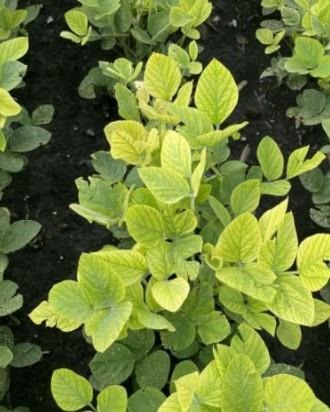By Meaghan Anderson and Antonio Mallarino
A common sight across the state this summer has been yellow or white patches of soybean in otherwise green fields. This ICM Blog will review several possible causes of yellow soybean and provide resources regarding each phenomenon.
Iron Deficiency Chlorosis (IDC)
Soybean IDC is a common issue in high-pH calcareous soils (usually with pH higher than 7.3 or 7.4) in low-lying soils and sometimes in eroded convex slopes or knolls in central, west central, and north central Iowa. However, field agronomists have been seeing seemingly typical IDC symptoms on high-pH soils in other areas of the state this year as well. Additionally, farmers and agronomists have noted that the symptoms seem particularly prominent this year.
IDC will result in pronounced yellow leaves with green veins on newer leaves (Figure 1). Except for severe IDC in highly calcareous soils, the symptoms may disappear as the season progresses. In the most affected areas, soybean leaves may drop, plants may not produce pods or plants could die. We occasionally notice that when the cause is calcareous soil, compacted areas, like wheel tracks, will show fewer symptoms or appear greener compared with surrounding rows. Research in Iowa, Kansas, and Minnesota calcareous soils have not been able to explain well this phenomenon, and compacting soil on purpose to minimize IDC is a risky practice. Soybean expressing symptoms are often under additional stress as well. Potassium deficiency sometimes is confused with IDC (see next section). While there is no in-season management option that would effectively eliminate IDC and reduced yield, this article explains some management considerations. Choosing a soybean variety that is tolerant to IDC is the most reasonable and cost-effective management strategy for soybean in these areas. Most companies offer these varieties. This north central region publication “Micronutrients for Soybean Production in the North Central Region” includes useful details about causes of nutrient deficiency symptoms, images, and possible management options.

Soybean exhibiting typical symptoms of iron deficiency chlorosis (IDC) with yellowed leaves and green leaf veins.
Potassium deficiency
Potassium deficiency symptoms may appear in some fields during reproductive growth stages, especially in dry years like this one or in soils testing low for potassium. Deficiency symptoms generally appear as yellowed leaf margins on middle or upper leaves. Early in the growing season, we expect to see these symptoms on older leaves, but for reasons that are not completely known, late-season potassium deficiency shows up near the top of the plant rather than older leaves. Read more about late-season potassium deficiency in this article.

Potassium deficiency symptoms, yellowed leaf margins, on soybean.
Soybean cyst nematode (SCN)
While the true sign of the presence of SCN is the presence of females on soybean roots, we may see signs aboveground in the form of stunted, yellowing plants. Aboveground yellowing is more likely to appear in droughty years like this one and SCN may be more easily identified near field entrances, high pH soils, and consistently low yielding areas. Iowa research has shown that calcareous soils increase SCN severity in infested fields. The symptoms can be non-descript, but carefully digging plants to examine roots for SCN females is key to identifying the issue. Read more in this 2021 ICM News article or check out the Soybean Cyst Nematode Field Guide.
HPPD inhibitor (Herbicide Group 27) herbicide carryover
Carryover of HPPD inhibiting herbicides has been more prevalent this year than in past years, likely due to the persistent dry conditions since last year. Since these herbicides interfere with pigments, affected plants produce yellow or white (bleached) soybean tissue. Leaves that emerge after exposure will bleached or yellow, with symptoms varying from entirely bleached leaves to bleached leaf margins. HG 27 carryover typically appears on early trifoliates, while symptoms of drift may appear on later leaves, depending on when the application occurred. Read more about herbicide injury on soybean from HG 27 products and others here. This Iowa IPM extension publication “Nutrient Deficiencies and Application Injuries in Field Crops” provides examples of plant injury and nutrient deficiency symptoms in soybean and other crops.
 Source : iastate.edu
Source : iastate.edu